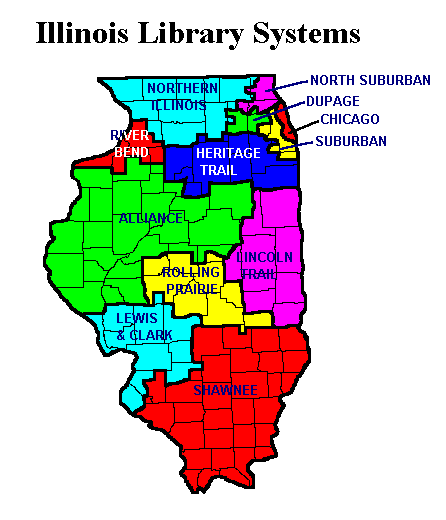Agency code
The Illinois library agency codes were a scheme of 3-letter codes created by the state library and the library systems to uniquely and concisely identify most libraries in the state, primarily for the purpose of delivering ILL materials and returned library materials to their proper library.
With some exceptions (e.g. ISL for the Illinois State Library, ELG rather than GBK for Gail Borden Public Library (Elgin), PCV rather than PCB for Putnam County Library, and the libraries in Iowa that were members of the River Bend Library System), the codes were made up of two letters for the library, plus one letter for the CLSI cluster (later, the library system).
| Code | Example | Library system | Current library system |
|---|---|---|---|
| A | PEA | Alliance Library System (ALS) (Originally Kaskaskia CLSI Cluster; now RSA) | RAILS |
| C | CPC | Chicago Library System (CLS) (Later renamed Chicago Public Library System (CMLS) when CPL became its own library system; partly merged into SWAN) | RAILS |
| D | ADD | Dupage Library System (DLS) | RAILS |
| B | OSB | Heritage Trails Library System (HTLS) (Originally Bur Oak CLSI Cluster; merged into PALS) | RAILS |
| E | Lewis & Clark Library System (LCLS) | IHLS | |
| N | OKN | Lincoln Trail Libraries System (LTLS) | IHLS |
| K | ALK | North Suburban Library System (NSLS) | RAILS |
| Q | CPQ | North Suburban Library System libraries that used to be part of NILS | RAILS |
| L | CVL | Northern Illinois Library System (NILS) (Merged into PALS) | RAILS |
| R | COR | River Bend Library System (RBLS) (Merged into PALS) | RAILS |
| P | RIP | Rolling Prairie Library System (RPLS) | IHLS |
| H | Shawnee Library System (SHLS) | IHLS | |
| S | BWS | Suburban Library System (SLS) (Merged into SWAN) | RAILS |
| O | Corn Belt CLSI Cluster | ? | |
| U | Cumberland CLSI Cluster | ? | |
| M | Great River CLSI Cluster | ? | |
| I | Illinois Valley CLSI Cluster | ? | |
| V | Starved Rock CLSI Cluster | ? | |
| W | Western Illinois CLSI Cluster | ? |
In 2012, the Illinois Library Delivery Service (ILDS), which delivers materials ILDS participants, changed its three-letter codes; now each library simply has a code for its former library system (as delivery services within the library systems are still divided by the old boundaries) rather than a unique code for the library that also identifies the system. Some of the former systems (including NSLS, and thus CCS) have continued to use the former codes internally.
